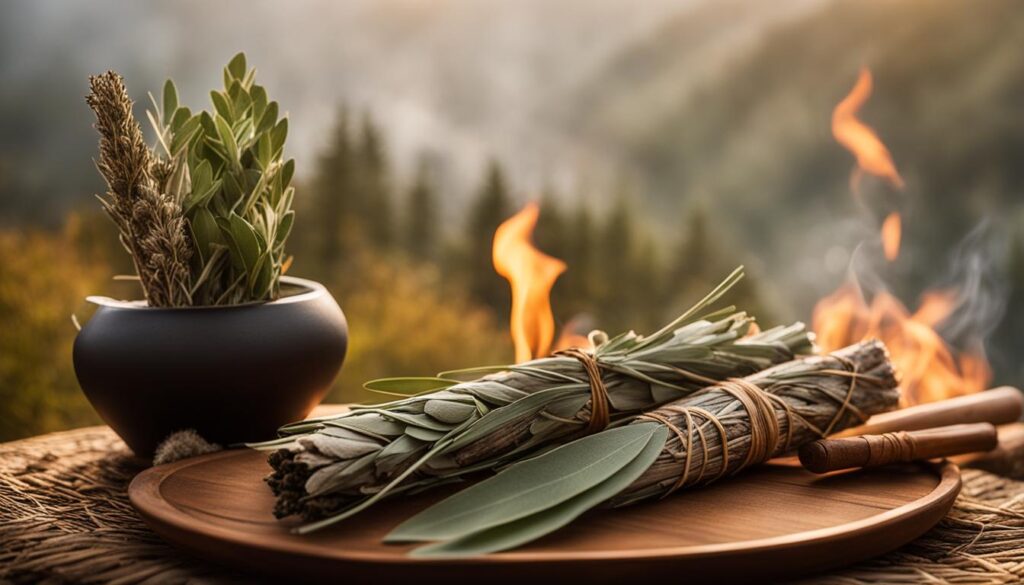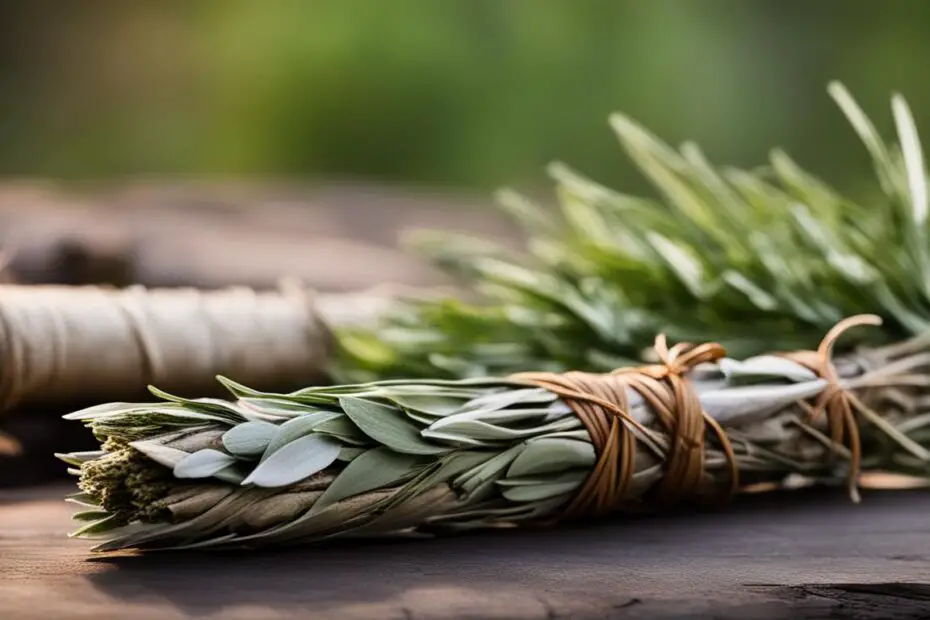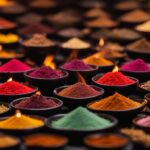Smudge sticks made with sage, cedar, and sweetgrass are powerful tools for purification and creating a peaceful atmosphere. Sage is known for its cleansing properties, cedar for protection and positive energy, and sweetgrass for peace and healing. These natural ingredients combine to create a potent tool for energy clearing and spiritual rituals.
Throughout history, cultures worldwide have recognized the significance of smudge sticks and their associated prayer tools. Let’s explore the main prayer tools, how they are used in practice, their symbolism, variations among sects, the materials used, and their evolution over time. We will also uncover unique lesser-known smudge stick ingredients, the healing benefits they offer, and their historical and cultural significance.
Key Takeaways
- Natural smudge sticks made with sage, cedar, and sweetgrass offer purification and peace.
- The main prayer tools of smudging practices are smudge sticks and an abalone shell or fireproof bowl.
- Smudge sticks are used by lighting the tip and wafting the smoke around the body or space.
- Each ingredient in a smudge stick carries its own symbolism, representing wisdom, protection, peace, and healing.
- While there may be variations among sects, the overall intention of smudging remains the same – to purify and create a sacred space.
Main Prayer Tools in Smudging Practices
Smudging practices involve the use of specific tools to perform rituals and ceremonies for purification and spiritual cleansing. The main prayer tools used in smudging practices are smudge sticks and an abalone shell or fireproof bowl. These tools play a crucial role in the smudging ritual and are essential for creating a sacred space.
A smudge stick is a bundle of dried herbs, such as sage, cedar, and sweetgrass, that are tied together with string or twine. It is lit at one end, allowing it to smolder and produce aromatic smoke. This smoke is used to cleanse and purify oneself and the surrounding environment. The choice of herbs used in a smudge stick may vary depending on personal preference or the specific intention of the ritual.
To catch the ashes and hold the burning smudge stick, an abalone shell or a fireproof bowl is typically used. The abalone shell is a traditional choice due to its connection to the ocean and the elements. The shell represents the water element and is believed to bring a sense of calm and harmony to the ritual. A fireproof bowl can also be used as a practical alternative.
“The main prayer tools used in smudging practices are smudge sticks and an abalone shell or fireproof bowl.”
Table: Main Prayer Tools in Smudging Practices
| Tool | Description |
|---|---|
| Smudge Stick | A bundle of dried herbs tied together that is lit to produce aromatic smoke for purification. |
| Abalone Shell | A shell traditionally used to catch the ashes and hold the burning smudge stick. |
| Fireproof Bowl | An alternative to an abalone shell, used for practicality and safety. |
The combination of the smudge stick and the abalone shell or fireproof bowl creates a powerful tool for spiritual cleansing and the creation of a sacred space. These tools are not only functional but also carry symbolic significance, enhancing the overall experience of the smudging ritual.
How Smudge Sticks are Used in Practice
Smudge sticks, made with sage, cedar, and sweetgrass, are widely used in spiritual practices for their purification and energetic cleansing properties. In practice, smudge sticks are utilized by lighting the tip and allowing it to smolder, producing a fragrant smoke. This smoke is then wafted around the body or throughout a space using a feather or fan. The act of smudging involves moving the smoke in a clockwise direction, starting from the feet and moving upwards to the head.
The purpose of smudging is to clear away negative energy, promote spiritual purification, and create a sense of wellbeing. By using smudge sticks, individuals can cleanse themselves and their surroundings, creating a sacred and harmonious environment. The soothing smoke emitted by the smudge sticks is believed to carry the intentions and prayers of the person performing the smudging ritual.
During the smudging process, the individual may recite prayers or affirmations that align with their personal beliefs and intentions. The act of smudging serves as a way to connect with higher energies, clear energetic blockages, and invite positive energy into one’s life. It is a meditative practice that promotes mindfulness and spiritual alignment.
Table: Steps for Using Smudge Sticks in Practice
| Step | Description |
|---|---|
| 1 | Light the tip of the smudge stick using a flame or candle. |
| 2 | Allow the flame to extinguish, leaving the smudge stick to smolder and produce smoke. |
| 3 | Hold the smudge stick with one hand and use a feather or fan with the other hand to waft the smoke around the body or throughout the space. |
| 4 | Move the smudge stick in a clockwise direction, starting from the feet and moving upwards to the head. |
| 5 | Intentionally focus on clearing negative energy and inviting positive energy while performing the smudging ritual. |
| 6 | Recite prayers, affirmations, or set intentions during the smudging process for a more personalized experience. |
By following these steps, individuals can effectively use smudge sticks in their spiritual practices to harness the power of purification, create a sacred space, and promote spiritual alignment.
The Symbolism of Smudge Stick Ingredients
Smudge sticks are not just bundles of herbs; they are powerful tools with deep symbolism. Each ingredient in a smudge stick carries its own meaning and energy, contributing to the overall intention of purification and spiritual cleansing. Let’s explore the symbolism behind some commonly used herbs in smudge sticks:
Sage:
Sage is associated with wisdom, cleansing, and purification. Its strong aroma is believed to dispel negative energy, ward off evil spirits, and bring clarity of thought. Burning sage in a smudge stick is like inviting the wisdom of the earth into your space, allowing for a fresh start and renewed energy.
Cedar:
Cedar is a symbol of protection and grounding. It is believed to have a strong connection to the spiritual realm, making it an essential ingredient in smudge sticks. The scent of cedar is said to purify and create a safe space, while also attracting positive energy. Burning cedar is like wrapping yourself in a comforting embrace, shielding you from negativity and fostering a sense of stability.
Sweetgrass:
Sweetgrass is associated with peace, healing, and harmony. Its gentle and sweet fragrance is believed to attract positive energies and spirits. Burning sweetgrass in a smudge stick is like inviting tranquility and balance into your surroundings, creating an atmosphere of serenity and well-being.
When these ingredients are combined in a smudge stick, their collective symbolism becomes a powerful tool for spiritual cleansing and creating a peaceful environment. Each ingredient works harmoniously to promote a sense of purification, protection, and balance.
Variations Among Sects
While the use of smudge sticks is common across different spiritual and religious sects, there may be variations in the specific herbs used or the rituals performed. Some sects may incorporate additional herbs or resins in their smudge stick formulations, depending on their specific beliefs and traditions. However, the overall intention of smudging remains the same – to purify, cleanse, and create a sacred space.
| Herb | Symbolism |
|---|---|
| Sage | Wisdom, cleansing, purification |
| Cedar | Protection, grounding, attracting positive energy |
| Sweetgrass | Peace, healing, harmony |
As with any ancient practice, the symbolism of smudge stick ingredients may vary across cultures and individuals. It is important to honor and respect these differences, as they contribute to the richness and diversity of spiritual practices.
Variations Among Sects in Smudging Practices
Smudging practices may vary among different spiritual and religious sects, with each incorporating their own unique traditions and beliefs into the ritual. While the core intention of smudging remains the same – purification and creating a sacred space – there can be variations in the specific herbs used, the rituals performed, and even the tools utilized.
Some sects may choose to include additional herbs or resins in their smudge stick formulations, depending on their specific cultural or spiritual practices. For example, certain Native American tribes may incorporate tobacco or sweet tobacco leaves into their smudge sticks, along with sage, cedar, and sweetgrass. Other sects may use specific herbs that hold significance within their faith or belief system.
Additionally, the rituals performed during smudging can also differ among sects. While some may follow a specific order or structure, others may allow for more flexibility and personalization. Some sects may incorporate chanting or prayers during the smudging process, while others may focus solely on the act of clearing and purifying the energy. The variations among sects in smudging practices highlight the diverse ways in which different cultures and spiritual beliefs engage with this ancient ritual.
Table: Variations in Smudging Practices
| Sect | Herbs Used | Rituals Performed |
|---|---|---|
| Native American | Sage, cedar, sweetgrass, tobacco | Chanting, prayers, clockwise movements |
| Wiccan | Sage, lavender, rosemary, mugwort | Invocation of deities, visualization, intention setting |
| Buddhist | Juniper, sandalwood, lotus | Recitation of mantras, mindfulness meditation |
Materials Used for Smudge Sticks
Smudge sticks, the powerful tools used for purification and creating a peaceful atmosphere, are typically made from dried herbs such as sage, cedar, and sweetgrass. These natural materials are carefully selected for their unique properties and symbolism in various spiritual practices. When crafting a smudge stick, it is important to use sustainably sourced and ethically harvested materials to honor the natural world and its resources.

The main ingredients in smudge sticks have specific meanings and energies. Sage is associated with wisdom, cleansing, and purification. Cedar represents protection and grounding of energy. Sweetgrass symbolizes peace, healing, and harmony. Combining these herbs in a smudge stick creates a synergistic blend that enhances the cleansing and purifying properties of the ritual.
Smudge sticks can be made by bundling the dried herbs together and securing them with string or twine. The choice of herbs may vary depending on personal preference or the specific intention of the smudging ritual. Some practitioners may also incorporate additional herbs or resins in their smudge stick formulations, based on their beliefs and traditions.
Evolution of Smudge Stick Ingredients Over Time
The ingredients used in smudge sticks have evolved over time as different cultures and spiritual practices have incorporated their own native plants and herbs. Traditionally, sage, cedar, and sweetgrass have been used by various Indigenous cultures in North America. With the growing popularity of smudging practices, there has been an increased exploration and use of other aromatic herbs and resins from around the world.
Table: Evolution of Smudge Stick Ingredients
| Traditional Ingredients | Newly Explored Ingredients |
|---|---|
| Sage | Palo Santo |
| Cedar | Lavender |
| Sweetgrass | Mugwort |
| Rosemary |
As people have become more interested in the spiritual and healing properties of smudge sticks, new ingredients have been incorporated to enhance the experience. Palo Santo, for example, is a wood known for its grounding and uplifting qualities. Lavender is often added to smudge sticks for its calming and soothing effects. Mugwort is believed to enhance intuition and dream work, while rosemary is associated with clarity and protection.
H3: Cultural Influences on Smudge Sticks
Different cultures and spiritual traditions have also introduced their own unique ingredients into smudge sticks. For example, in traditional Chinese medicine, mugwort is used for its healing properties and is often included in smudge sticks used in Eastern practices. The use of frankincense and myrrh in smudge sticks can be traced back to ancient Egyptian and Middle Eastern cultures.
Unique Lesser-Known Smudge Stick Ingredients
While sage, cedar, and sweetgrass are commonly used ingredients in smudge sticks, there are also several unique and lesser-known herbs and plants that can be incorporated into these powerful tools. These lesser-known ingredients add their own special properties and energies to the smudging ritual, allowing for a more personalized and nuanced experience.
Palo Santo: Known as “holy wood,” palo santo is native to South America and has a sweet and uplifting fragrance. It is often used for purification, grounding, and creating a sacred space. Palo santo is believed to enhance clarity, creativity, and spiritual connection.
Lavender: Lavender is a popular herb known for its calming and soothing properties. Its gentle aroma helps to promote relaxation, reduce anxiety, and improve sleep. Incorporating lavender into a smudge stick can enhance the overall sense of tranquility and peace during the smudging ritual.
Mugwort: Mugwort is an herb with ancient roots in traditional healing practices. It is associated with protection, divination, and deepening psychic abilities. Adding mugwort to a smudge stick can help enhance intuition, clarity, and spiritual insight.
Rosemary: Rosemary is a versatile herb used for various purposes, including purification and memory enhancement. Its invigorating scent can help to clear the mind and stimulate mental clarity. Including rosemary in a smudge stick can promote focus, concentration, and positive energy.
By incorporating these unique and lesser-known smudge stick ingredients into your spiritual practices, you can customize your smudging rituals to suit your specific intentions and desired effects. Each herb carries its own energetic properties and can contribute to a more meaningful and transformative experience.
The Healing Benefits of Smudge Sticks
Smudge sticks have long been revered for their healing properties and the positive effects they can have on the mind, body, and spirit. When burned, the aromatic smoke produced by smudge sticks can help to purify the air and release negative energy, creating a sense of healing and balance.
One of the main healing benefits of smudge sticks is their ability to promote emotional wellbeing. The act of smudging can help to reduce stress, anxiety, and feelings of negativity, creating a calming effect on the mind and promoting a sense of tranquility.
Smudge sticks are also known for their energetic clearing properties. The smoke produced by burning sage, cedar, and sweetgrass can cleanse and purify the energy of a space, removing any stagnant or negative energy and creating a more positive and harmonious environment.
“The act of smudging involves more than just clearing the air; it involves cleansing the mind and spirit as well.”
Furthermore, smudge sticks can be used as a form of natural aromatherapy. The pleasant scent of sage, cedar, and sweetgrass can enhance relaxation, promote mental clarity, and create a soothing atmosphere. This makes smudge sticks a perfect tool for creating a peaceful and calming environment, whether it’s during meditation, yoga, or simply to unwind after a long day.
Overall, the healing benefits of smudge sticks make them a valuable tool for anyone seeking to cleanse their energy, promote emotional wellbeing, and create a sense of peace and harmony in their life and surroundings.

Aromatherapy and Natural Incense with Smudge Sticks

Smudge sticks, in addition to their spiritual and energetic purposes, can also be used for aromatherapy and as natural incense. When the herbs in a smudge stick are burned, they release fragrant smoke that can enhance relaxation, promote mental clarity, and create a soothing atmosphere. The scent of sage, cedar, and sweetgrass in smudge sticks can be compared to natural incense, providing a pleasant aroma that promotes a sense of calm and tranquility.
Aromatherapy is the practice of using the natural scents of plants and herbs to promote physical, mental, and emotional well-being. It has been used for centuries to improve mood, reduce stress, and create a sense of relaxation. Smudge sticks, with their aromatic smoke, can be a wonderful addition to aromatherapy rituals. The calming and grounding scents of sage, cedar, and sweetgrass can help create a peaceful environment and promote a sense of inner balance.
Using smudge sticks as natural incense allows you to enjoy the benefits of aromatherapy while also purifying and cleansing your space. The fragrant smoke can help eliminate odors and stale energy, leaving your environment feeling refreshed and revitalized. Whether you are practicing mindfulness, meditation, or simply looking to create a peaceful ambiance, smudge sticks can provide a natural and aromatic solution.
Benefits of Aromatherapy with Smudge Sticks:
- Promotes relaxation and stress relief
- Enhances mental clarity and focus
- Creates a calming and soothing atmosphere
- Purifies and cleanses the air and energy
- Brings a sense of balance and harmony
By incorporating smudge sticks into your daily rituals, you can experience the combined benefits of purification, energetic clearing, and aromatherapy. Enjoy the soothing scents, embrace the peaceful ambiance, and allow the fragrant smoke to enhance your overall well-being.
The Historical and Cultural Significance of Smudge Sticks
Smudge sticks have a deep historical and cultural significance, particularly within Indigenous cultures in North America. These cultures have long utilized smudge sticks as a vital component of their spiritual practices, incorporating them into purification ceremonies, prayers, and rituals. Although specific smudging practices may vary among different tribes and nations, the intention remains consistent – to cleanse, purify, and create a sacred space.
Smudging holds a profound meaning for Indigenous communities, representing a connection to their ancestral traditions, land, and spirits. The act of smudging with a smudge stick is seen as a way to honor and communicate with the divine, as well as to seek protection and guidance. It is a practice deeply rooted in respect for the natural world and the interconnectedness of all beings.
“The act of smudging with a smudge stick is seen as a way to honor and communicate with the divine, as well as to seek protection and guidance.”
In recent years, the popularity of smudging has extended beyond Indigenous cultures and spread to other spiritual and alternative healing communities around the world. People from various backgrounds have recognized the power and benefits of smudging for their own spiritual journeys and wellbeing. As a result, the use of smudge sticks has become more widespread and diverse, incorporating a range of herbs, plants, and rituals.
Smudge sticks, with their rich historical and cultural significance, continue to be an essential tool for individuals seeking purification, energetic clearing, and a deeper connection to themselves and the world around them.
Conclusion
Smudge sticks, made with sage, cedar, and sweetgrass, are powerful tools for purification and creating a peaceful atmosphere. They are used in various spiritual practices and have a rich historical and cultural significance.
Smudging with a smudge stick involves using the main prayer tools of smudge sticks and an abalone shell or fireproof bowl. The smudge stick is lit to produce aromatic smoke, while the shell or bowl catches the ashes. This ritual is performed by wafting the smoke around the body or throughout a space using a feather or fan, in a clockwise direction.
Each ingredient in a smudge stick carries its own symbolism, with sage representing wisdom and purification, cedar symbolizing protection and grounding, and sweetgrass symbolizing peace and healing. While there may be variations among different sects in the specific herbs used or rituals performed, the overall intention of smudging remains the same – to purify, cleanse, and create a sacred space.
Smudge sticks are typically made from dried herbs, such as sage, cedar, and sweetgrass, which are bound together with string or twine. However, there are also unique and lesser-known herbs and plants that can be incorporated into smudge sticks for specific intentions or desired effects.
FAQ
What are the main ingredients in a smudge stick?
The main ingredients in a smudge stick are sage, cedar, and sweetgrass.
What are smudge sticks used for?
Smudge sticks are used for purification and creating a peaceful atmosphere.
How are smudge sticks used in practice?
Smudge sticks are lit and allowed to smolder, producing smoke that is wafted around the body or throughout a space.
What is the symbolism of the ingredients in a smudge stick?
Sage represents cleansing and purification, cedar represents protection, and sweetgrass symbolizes peace and healing.
Are there variations in smudging practices among different sects?
Yes, different sects may use different herbs or incorporate additional herbs and resins in their smudge sticks depending on their beliefs and traditions.
What materials are used for making smudge sticks?
Smudge sticks are typically made from dried herbs such as sage, cedar, and sweetgrass, which are bound together with string or twine.
How have the ingredients in smudge sticks evolved over time?
Different cultures and spiritual practices have incorporated their own native plants and herbs into smudge sticks.
Are there other herbs that can be used in smudge sticks?
Yes, other herbs such as palo santo, lavender, mugwort, and rosemary can be used in smudge sticks for specific intentions or desired effects.
What are the healing benefits of smudge sticks?
Smudge sticks can help purify the air, release negative energy, and promote emotional healing, reducing stress and creating a peaceful environment.
Do smudge sticks have aromatic qualities?
Yes, burning herbs in a smudge stick releases fragrant smoke that can enhance relaxation, promote mental clarity, and create a soothing atmosphere.
What is the historical and cultural significance of smudge sticks?
Smudge sticks have a long-standing tradition in Indigenous cultures in North America, where they are used for purification, prayer, and ceremony.









